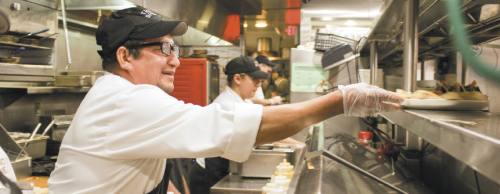A series of prominent developments in Plano is expected to bring tens of thousands of jobs to the city in the coming years—but it will be harder to fill some of those job openings than others.
From the executives and staff in brand-new, sparkling corporate offices, to the cooks and servers in restaurants at the Legacy West development, the demand for labor in Plano is diverse and growing. But local business leaders have said the Plano restaurants, retail stores and hospitality employers that have struggled for years to retain their workers could be in for a harder time in the coming months.
“In a community like Plano where you have a large number of restaurants, retail [and] hotels that are coming online at once, you have a lot of competition” for labor, said Jamee Jolly, president and CEO of the Plano Chamber of Commerce.
Part of the issue, Jolly said, is tied to the cost of living in Plano, where fewer service-industry and retail professionals can afford to live than in some other areas of North Texas. The average home in Plano is valued at well over $300,000, and apartment rents tend to be higher than most low-wage earners can afford, she said.
These same conditions, common throughout Collin County, mean the area draws a high concentration of educated residents that higher-paying employers would like to attract. More than half of Plano residents have a bachelor’s or graduate degree, compared with fewer than 1 in 4 residents in the Dallas-Fort Worth area at large.
 The local labor market has been moving in this direction for years, even before the latest round of development in Plano, state demographer Lloyd Potter said.
The local labor market has been moving in this direction for years, even before the latest round of development in Plano, state demographer Lloyd Potter said.
“There’s been a shift of the occupation of people that are in the labor force toward higher-skilled, higher-paid jobs, and away from the lower-skilled, lower-paid jobs,” Potter said.
Looking outside for answers
The restaurant industry is known for its chronic struggle to maintain stable staffs, but the past three years have been the most difficult Javier Ventura can remember.
Ventura, general manager for the Taco Diner location at The Shops at Legacy, said he works regularly to fill vacancies on his high-turnover restaurant staff.
“I will say that 80 percent of the people that I hire are going to be young, really young people,” Ventura said. “Those are the ones that either they last for one month or they just work for maybe a couple weeks and they say, ‘You know what, it’s just not for me.’”
Over time, Ventura said, the older, more experienced employees tend to stick around longer than younger employees with less experience. However, most of these employees who constitute the backbone of his staff do not live in Plano, he said.
“It’s people that come from Dallas, Garland, maybe Carrollton, because I guess they find it a little bit more hard for them to find a job,” Ventura said.
The restaurant starts employees off at $11 to $12 an hour in an effort to attract more candidates, Ventura said. When out-of-town candidates express interest in working at Taco Diner, however, Ventura said they will often hesitate when they learn the exact location.
Other business owners and managers have reached out to the chamber with similar stories of hiring difficulties, Jolly said.
“When you’re talking about an hourly job, to ask someone to drive across North Texas to get to that job is not really feasible,” Jolly said. “Plano is surrounded on three sides by a toll road. That can be cost-prohibitive when you’re talking about a lower-wage-earning job.”
Antonio Oreste, a 42-year-old cook at Ventura’s restaurant, drives to work from his home in Garland each day.
After he finishes his shift at Taco Diner each day, Oreste walks to a second job at another restaurant.
For other potential employees who, unlike Oreste, depend on public transportation to get to work, a broad swath of Plano is not served directly by rail or buses. That said, Plano is more connected to the Dallas Area Rapid Transit network than suburbs to the north.
“We do have light rail into our eastern sector, and that’s been very good for the restaurant industries on the eastern portion that have been able to bring in talent from Dallas and other areas; that’s been great,” Jolly said. “We are increasing the [bus] routes … into Legacy and Legacy West.”
Increasing these bus routes is a step Ventura and other employers in The Shops at Legacy have sought for a while, Ventura said.
Plano’s relative shortage of service-industry labor is not unexpected in light of the city’s demographic trends, said Potter, the state demographer who also serves as director of the Institute for Demographic and Socioeconomic Research at the University of Texas at San Antonio.
The bulk of new people moving into the Collin County suburbs, Potter said, are moving to Texas from other states like California.
“Collin County,” he said, “is this mecca of migration.”
Those willing to move to Collin County from out of state are likely to be wealthier than those simply moving between Texas counties, and therefore more likely to seek a high-paying corporate job rather than a lower-wage job, Potter said.
“The people that are moving [to Collin County] are those that employers aren’t having problems finding,” Potter said. “There are people who can afford the housing market there, who have higher levels of education and have the resources usually to move there, many of them from out of state.”
However, immigration patterns could also be depleting the supply of low-skill labor in a second way, Potter said. National analyses of government data from Pew Research Center and other sources suggest immigration from Mexico may be in a decline that dates back to the Great Recession.
“We’ve seen at the United States level, a leveling off [of Mexican immigration],” Potter said. “And some people even estimate that there’s been a reversal of the flow of migrants from Mexico—that more migrants [are] going to Mexico than are coming to the United States.”
Although Potter does not know of studies that have tested this national trend at the state or local level, he said Mexican nationals choosing to leave in greater numbers would have a disproportionate effect on the service-industry, restaurant and hospitality employers that have historically relied on such labor.
“We have a pretty significant dependence on labor of immigrants from Mexico, both authorized and unauthorized,” Potter said.
High cost of housing
Home prices are rising in Plano, but area apartments are not getting cheaper, either.
New apartment communities are popping up across the city, many as part of mixed-use developments coming online, including Legacy West on the city’s northwest corner and Heritage Creekside on its southern border.
But many of these apartments are aimed at the young professionals who may be living and working in the offices nearby. The lowest rent at one Heritage Creekside apartment community, for instance, is over $1,000 per month. Figures like that are more than what many who earn service-industry wages can afford, Jolly said.
“With the housing costs currently the way they are in Plano and most of our immediately surrounding communities, it’s cost-prohibitive for those folks to live and work here,” Jolly said.
Jolly said some measures companies have used include offering competitive wages and benefits, as well as flexible hours compared with competitors more central to Dallas.
Despite the continued hiring difficulties many employers in the retail and service industries are having, Jolly said she believes they will manage the new challenges as they have until now.
“Again, there’s a lot of competition, but I feel good that they’re aware of it,” Jolly said. “They’re doing their best to be proactive.”






